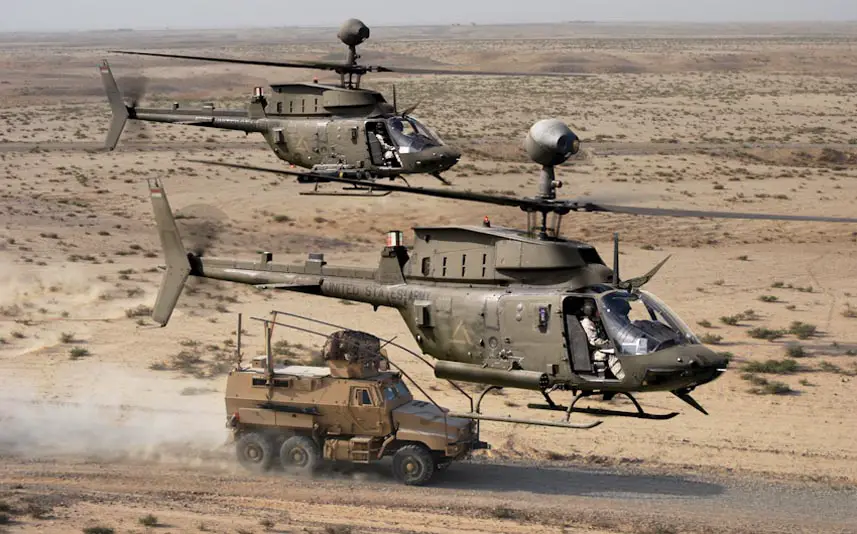The Bell OH-58 Kiowa is a family of single-engine, single-rotor, military helicopters used for observation, utility, and direct fire support. Bell Helicopter manufactured the OH-58 for the United States Army based on its Model 206A JetRanger helicopter. The OH-58 was in continuous U.S. Army service from 1969 to 2017, when it was replaced in this role by the Boeing AH-64 Apache. The Army considered retiring the Kiowa as part of a wider restructuring to cut costs and reduce the various types of helicopters in service. The Analysis of Alternatives (AoA) for the AAS program found that the Kiowa operating alongside RQ-7 Shadow UAVs was the most affordable and capable solution; it also said that the AH-64E Apache Guardian was the most capable “immediate” solution for the scout helicopter role. The latest model, the OH-58D Kiowa Warrior, is primarily operated in an armed reconnaissance role in support of ground troops. The OH-58 has been exported to Austria, Canada, Croatia, the Dominican Republic, Taiwan, Saudi Arabia, and Greece. It has also been produced under license in Australia.

The OH-58D introduced the distinctive Mast-Mounted Sight (MMS) above the rotor system, and a mixed glass cockpit, with traditional instruments identified as “standby” for emergency use. The MMS has a gyro-stabilized platform containing a television system (TVS), a thermal imaging system (TIS), and a laser range finder/designator (LRF/D). These new features gave the aircraft the additional mission capability of target acquisition and laser designation in day or night, limited-visibility and adverse weather.A roof-mounted Saab HeliTOW sight system was opted for in place of the MMS. The 406CS also had detachable weapon hardpoints on each side. The Kiowa Warrior, sometimes referred to by its acronym KW, is the armed version of the OH-58D Kiowa. The main difference that distinguishes the Kiowa Warrior from the original AHIP aircraft is a universal weapons pylon found mounted on both sides of the aircraft. These pylons are capable of carrying combinations of AGM-114 Hellfire missiles, air-to-air Stinger (ATAS) missiles, 7-shot 2.75 inches (70 mm) Hydra-70 rocket pods, and an M296 .50 caliber machine gun.

The OH-58F is the designation for an upgrade of the OH-58D. The Cockpit and Sensor Upgrade Program (CASUP) features a nose-mounted targeting and surveillance system in addition to the OH-58D’s mast-mounted sensor. The AAS-53 Common Sensor Payload (CSP) includes an advanced infrared camera, color Electro-Optical camera, and image intensifier; it is expected to improve flight performance by 1–2% through weight and drag reductions. Survivability enhancements include ballistic floor armor and the Common Missile Warning System (CMWS). Unlike most military projects, the Army designed and built the new variant itself, which lowered developmental costs. The Army chose to retire its Kiowa fleet and end the F-model CASUP upgrades. CASUP and SLEP upgrades would cost $3 billion and $7 billion respectively, totaling $10 billion for features that the Army cannot afford to allocate money to.

On April 14, 2011, Bell performed the successful first flight of their OH-58F Block II variant. The Block II was Bell’s entry in the Armed Aerial Scout program. It built on the improvements of the F-model, and added features including the Honeywell HTS900 turboshaft engine, the transmission and main rotors of the Bell 407, and the tail and tail rotor of the Bell 427. The F-model Kiowa is an “obsolescence upgrade”, while the Block II was seen as the performance upgrade. This gave the Army flexibility in times of shrinking budgets, as they had the option of upgrading the Kiowa to the F-model and then continuing to the Block II later when there were sufficient funds. The Army ended the AAS program in late 2013. With the onset of sequestration budget cuts in early 2013, it was decided that the $16 billion cost of buying new armed scout helicopters was too expensive.















